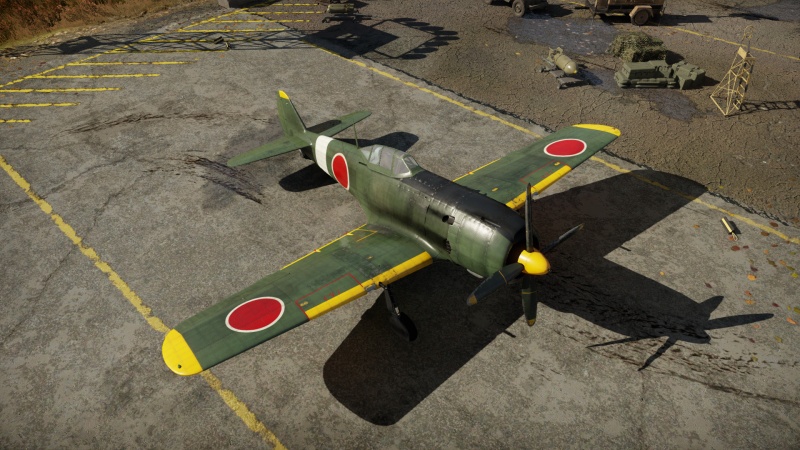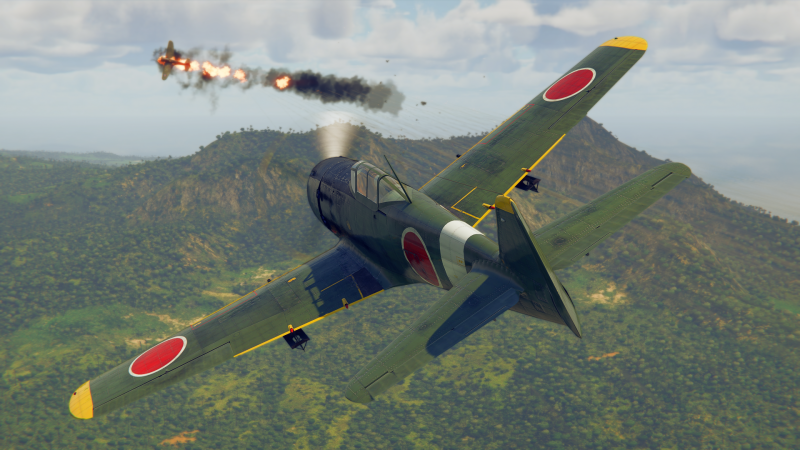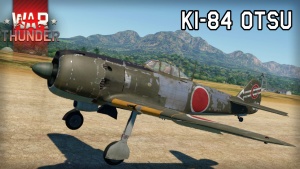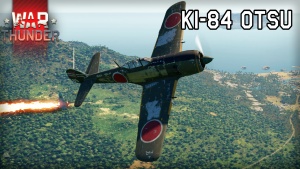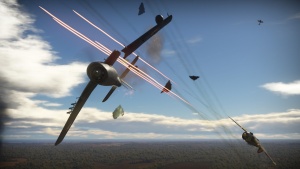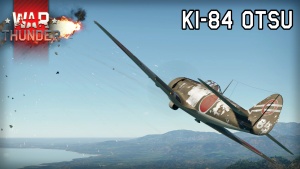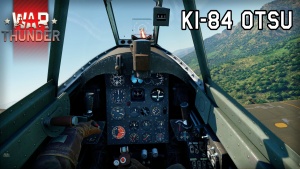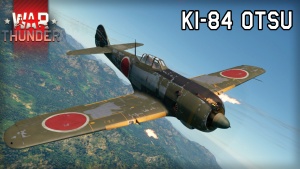Ki-84 otsu
| This page is about the Japanese fighter Ki-84 otsu. For other versions, see Ki-84 (Family). |
Contents
Description
The Ki-84 otsu Hayate is a rank Japanese fighter with a battle rating of (AB), (RB), and (SB). It was introduced in Update 1.37.
General info
Flight performance
The Ki-84 Otsu is a very stable platform that can easily compete with its contemporaries at the tier. It has an excellent top speed and acceleration for a Japanese aircraft, but is still quite a bit lacking when compared to aircraft like the late 109's, Ta 152, Bearcat, P-51H, and the Griffon Spitfires. However, its most powerful trait is its excellent manoeuvrability. The Ki-84 will be able to outturn anything it faces with the usage of combat flaps that's not a Spitfire or Re.2005 (with the exception of other Japanese fighters like the A6M5). Overall it is an enjoyable aircraft to fly due to its excellent manoeuvrability, competitive top speed and acceleration, and smooth controls, but the pilot must take care at speeds above 630 km/h as the aircraft will stiffen up considerably.
| Characteristics | Max Speed (km/h at 6,000 m) |
Max altitude (metres) |
Turn time (seconds) |
Rate of climb (metres/second) |
Take-off run (metres) | |||
|---|---|---|---|---|---|---|---|---|
| AB | RB | AB | RB | AB | RB | |||
| Stock | 669 | 650 | 20.2 | 20.8 | 14.1 | 14.1 | 421 | |
| Upgraded | 719 | 692 | 19.1 | 19.4 | 22.6 | 17.9 | ||
Details
| Features | ||||
|---|---|---|---|---|
| Combat flaps | Take-off flaps | Landing flaps | Air brakes | Arrestor gear |
| ✓ | ✓ | ✓ | X | X |
| Limits | ||||||
|---|---|---|---|---|---|---|
| Wings (km/h) | Gear (km/h) | Flaps (km/h) | Max Static G | |||
| Combat | Take-off | Landing | + | - | ||
| 470 | 431 | 280 | ~13 | ~10 | ||
| Optimal velocities (km/h) | |||
|---|---|---|---|
| Ailerons | Rudder | Elevators | Radiator |
| < 400 | < 480 | < 430 | > 324 |
| Compressor | Optimal altitude | 100% Engine power | WEP Engine power |
|---|---|---|---|
| Setting 1 | 2,000 m | 1,875 hp | 2,100 hp |
| Setting 2 | 5,300 m | 1,675 hp | 1,876 hp |
Survivability and armour
- 13 mm steel backrest
- 6 mm steel headrest
- 70 mm bulletproof windshield, sloped
Modifications and economy
Armaments
Offensive armament
The Ki-84 otsu is armed with:
- 2 x 20 mm Ho-5 cannons, nose-mounted (150 rpg = 300 total)
- 2 x 20 mm Ho-5 cannons, wing-mounted (150 rpg = 300 total)
The Ho-5's are very volatile weapons when approached from a beginner's standpoint. Their reasonably high rate of fire combined with lower than average muzzle velocity and poor HE round makes it so that one must be fairly close to deal significant damage. Fortunately, they are quite accurate and do not jam as badly as its competitors such as the Hispano Mk.II/Mk.V and do not perform as badly as the Russian ShVAK. Your belt of choice should be "Universal" or "Tracers", with Tracers dealing the most consistent damage and being easier to aim due to not having to deal with the velocity difference between the HE shell and the Tracer shell.
Suspended armament
The Ki-84 otsu can be outfitted with the following ordnance:
- Without load
- 2 x 50 kg Army Type 94 GPHE bombs (100 kg total)
- 2 x 250 kg Army Type 92 GPHE bombs (500 kg total)
Usage in battles
The "Otsu" modification is the middle child of the Ki-84 family, dropping the 12.7 mm heavy machine guns from the previous model in favour of two additional Ho-5 20 mm cannons, boosting firepower considerably. It retains the same strengths and weaknesses of said previous model. Equipped with a 2,000 HP engine, this aircraft's performance is on par with that of the legendary P-51 Mustang. However, unlike the Mustang, the Ki-84 has solid turning characteristics and excellent climb rate thanks to its lighter weight. This being said, the Ki-84 also has good energy retention, so try to make your opponent bleed energy to have an edge. The Ki-84 was also one of the first mass-produced Japanese aircraft to come equipped with armoured glass, armour plates and self-sealing fuel tanks, but the armour is still lacklustre compared to its Russian and American counterparts. However, as always, not everything is perfect. The aircraft controls stiffen significantly at speeds above 630 km/h, making even slight adjustments to heading impossible. Thus, at higher speeds, its elevator suffers. The Ki-84 also suffers a lot when no modules are researched, making the aircraft almost useless until modifications are unlocked.
This aircraft should be played as it appears: a lightweight Japanese version of the Mustang, retaining good engine performance, decent climb-rate, high diving performance and relatively lacklustre armament, although fairly improved from the previous model.
Unfortunately, the increased firepower comes at the cost of a higher battle rating, especially so in Arcade Battles. While a 0.3 BR increase in Realistic Battles isn't that bad on the surface, it allows you to face vastly superior aircraft such as the F8F-1B, Spitfire F Mk 24 and P-51H-5-NA that outclass you in almost every way. In arcade, the BR increase is a lot less subtle, a whole 1.3 BR increase to be precise. This increase causes the aircraft to occasionally be up-tiered into 7.0 matches with jet aircraft that will walk all over the poor Ki-84. Fortunately for the Hayate, it retains its advantage of excellent engine power - and by extension, top speed, climb rate and energy retention - and superb manoeuvrability that can turn with nearly every aircraft at the tier. While the Ko modification of the aircraft was brutal to play efficiently, the Otsu is a lot more forgiving, but can still wreak havoc in the hands of a skilled pilot.
Flying Styles
The Ki-84 Otsu is an aircraft that can tailor to any form of dogfighting its pilot can dream of. Its high top speed, decent acceleration, excellent manoeuvrability, great climb rate, and superb energy retention create a very stable platform when used properly, and a skilled Ki-84 pilot can single-handedly dictate the flow of the battle.
Basic Combat
The excellent energy retention combined with fantastic manoeuvrability allow the Ki-84 to be a very solid energy fighter that can easily compete with the 109's and the various Italian fighters at its tier. Ideally you should make use of the Vertical spiral or Zoom manoeuvre to bleed your prey's energy then pounce while they're recovering. Do take care to avoid roll-intensive manoeuvres such as scissors or lag rolls, as the Ki-84 has a mediocre roll rate that only gets worse with speed as a result of its severe compression.
Of course due to being a Japanese fighter, the naturally excellent raw manoeuvrability of the Hayate allows it to be a more than capable classic dogfighter who specializes in Turn-N-Burn tactics that can easily get on a bandit's tail. However it is noteworthy than the aircraft can struggle to regain its energy once it has bled it by turn-fighting, so avoid flat turns and go for climbing and diving turns instead so as to quickly regain its advantages.
Defensive Flying
Of course, there are scenarios where the Ki-84's pilot will have to go on the defensive. The aircraft cannot afford to take many hits, so avoiding as many shots as possible is mandatory for your survival. Defensive energy manoeuvres such as the Immelmann, Defensive spiral and the various Yo-Yo's should be your first choice when being attacked. If an enemy is diving on you, try to force an overshoot with your excellent manoeuvrability and engage while the enemy is zoom-climbing.
Simulator Battles
- In Simulator, the Ki-84 is overall a decent plane to fly. It enjoys lovely visibility towards the rear, sides, above, and over the nose, giving the pilot great situational awareness. It has nice handling, good climb rate, great speed and acceleration. Armament wise, the guns have enough fire rate to put quite a few projectiles into the target in one pass. However the Ki-84's disadvantages are the limited damage, poor rudder efficiency at high speeds, the rather slow roll rate, and the compass at the front-right of the gunsight that can obstruct your view. This aircraft can be used in BnZ fighting, turn fighting, intercepting (to some extent) and some ground pounding.
- Before taking off, bring at least 30 minutes of fuel for longer patrol time. Set the convergence to around 250 m since your weapons have low velocity, therefore needing more precise aim at longer range. While your Ki-84 roars down the runway, you will notice that it shifts severely to the left, thus you must put rudder input to the right to taxi straight. As with other Ki series aircraft, only elevator trim is available, so when the stick is at its deadzone, the Ki-84 will roll and yaw to the left side. Therefore you always need to pull the stick a little to the right which can get a bit annoying. Usually, trim for around -1% when cruising around 470 km/h, around -5% when diving around 600 km/h, and when fighting at around 400 km/h no negative trim is needed. When carrying the 2x 250kg bombload, no negative trim is needed as well. Landing characteristics are forgiving: cut throttle to make sure you are not above 350 km/h before touchdown. Deploy combat then takeoff flaps to further decelerate in preparation for extending landing gears. Extend at around 260 km/h, control your descend rate throughout. Right before touchdown, deploy landing flaps. The gears are quite sturdy. You can break until the plane reaches full stop and not worry about propeller strike.
- For dogfighting, it is always safer to enter with an altitude advantage. Most dogfights in Sim happen around or below 3,000 m so the Ki-84 can easily climb up to that altitude. Once at an advantageous height, boom & zoom the enemies. The Ki-84 can easily accelerate to more than 550 km/h in a dive which is decently fast but requires more precise manoeuvres to get the correct lead, since the faster you go the smaller the shooting window is. Important note: when fighting above 550 km/h, you want to be more precise in the roll and pitch axis, since at this speed the rudder locks up severely, preventing you from making aim adjustments which negatively impacts the lead. You must pretend that your rudder doesn't exist and fully rely on the ailerons and elevators to lead. A successful pass can usually cripple the enemy. Aside from BnZ, the Ki-84 is also excellent at turn fighting - with the appropriate opponent, of course. Except a few dedicated turn fighters, the Ki-84 can out-turn and get on most opponents' tail with combat/takeoff flaps deployed, and can sustain its turning ability throughout the fight. The Ki-84's stable handling allows you to pull some tight manoeuvres, so don't worry too much about flat spins. If you become a prey, try some defensive manoeuvres like barrel rolls or disengage by diving steeply towards a nearby friendly airfield. Note that the Ki-84's roll rate is very average so avoid manoeuvres like scissors.
- When performing the "destroy enemy surveillance aircraft/attackers/bombers" task, it is crucial to constantly evade the turrets. If it is a bomber/attacker with decent defensive firepower or robust protection, then you might want to disengage after some attempts if you don't want to die. Pay special attention to any plane equipped with M2 Browning MG, they can critically damage the Ki-84 especially on the engine, fuel tanks, and pilot which can always lead to a later crash. Before attacking try to get an altitude advantage and perform deflection shots. To maximise the damage it is better to aim for their wings and engines, as the fuselage usually soaks up quite some bullets. Only fire when the bomber passes in front of your guns. This short window is enough to cripple a twin-engine aircraft thanks to the 4 cannons, but it can require more passes to destroy one. However sometimes it only takes one bullet to set the target aflame. DO NOT follow behind a bomber's 6 unless you are sure that its tail gunners are unconscious. Chasing behind a bomber makes yourself pretty much stationary for the tail gunners, and you will be showered with bullets.
- For ground pounding, the best loadout is the 2 x 250 kg bombs. With an extra 500 kg of weight attached outside, the Ki-84 handles much clumsier during take offs, especially on the roll axis. Longer distance is needed before lifting off. It is quite easy to drop bombs accurately with a Ki-84 because this aircraft is able to quickly accelerate above 550 km/h in a dive, the bombs will travel an almost straight line towards the target, therefore you can aim the gunsight directly at the target and expect the bombs to land very close. After bombs away, immediately pull up. The 4 Ho-5's perform well in killing trucks, AA guns and artilleries as they are quite accurate, but do not waste cannon shells on these targets unless you must. Constantly watch your surrounding, especially your high 6 for any incoming enemies.
Enemies worth noting:
- Me 264: The Me 264 is armed with large calibre MG and cannons all over it, therefore tailing a 264 is basically suicide unless all of their gunners are knocked out. You can treat the 264 almost like a B-29 or B-17 as they are very similar in both design and defensive capabilities. It is best to head-on the 264 if you can as you can easily knock out the pilots due to its glazed nose while also taking minimal damage. However the bomber lacks a ventral turret on its belly, making it easy to deal damage from below, but be wary of the downwards facing rear 20 mm cannon near the tail. The safest way to attack is from a higher altitude, dive at an oblique angle and focus fire on the wings and nose. Never engage if you have no altitude advantage. Looking somewhat similar to a B-17, an Me 264 has huge back-swept wings with 2 engines on each, and a H-tail which differentiates it from a B-17/B-29.
- Yak-3: this is a capable dogfighter or BnZ fighter that can be a huge threat. Although its firepower is not deadly, it can still critically damage a Ki-84. It is able to fly or dive at similar speeds, and can even engage a turn fight with a Ki-84 that is using takeoff flaps. The Yak-3 has a straight dorsal line housing an inline engine, a bubble canopy with a huge cooling intake sticking out the belly, and its symbolic, triangular wings.
- A6M, Spitfire, etc: If you see these turn fighters on your tail try outrunning them by diving at around -40 degrees. The Ki-84 still remains responsive handling at 600 km/h, but its speed retention is not the best, meaning it will start to lose speed quickly and the enemy might catch up. If you are near a friendly airfield, great. If not, then hope for the best and run towards the friendly side. A Spitfire also has an uncurved dorsal outline and large, elliptical wings. A Zero has a radial engine that's usually painted black, rounded wingtips and stabiliser tips followed by a pointy tail.
- Ju 288 C: this is a very common bomber in air RB. Their tactics generally fall into two styles: shallow dive bombing and conventional climbing. For the ones that shallow dive towards a bomb base at the start of the match, think twice before engaging. The Ju 288 is very fast for a bomber, being able to reach >500 km/h in a shallow dive which makes it quite hard for an attacker to BnZ it, as it will be slow to catch up to it, giving it long enough time to shoot back. The Ki-84 locks up past 550 km/h, plus the mediocre damage, it is best to leave it for heavy-punching teammates. As for the Ju 288 that climb, do not engage if you have no altitude advantage. It has numerous guns with great downward coverage, posing a big threat to the fragile Ki-84.
Manual Engine Control
| MEC elements | ||||||
|---|---|---|---|---|---|---|
| Mixer | Pitch | Radiator | Supercharger | Turbocharger | ||
| Oil | Water | Type | ||||
| Controllable | Controllable Not auto controlled |
Controllable Not auto controlled |
Controllable Not auto controlled |
Separate | Controllable 2 gears |
Not controllable |
Pros and cons
Pros:
- Excellent manoeuvrability, among the best in its rank
- Competitive speed and acceleration
- Reasonably powerful armament with a decent amount of ammo
- One of the most underestimated aircraft at the rank
- Above-average climbing rate
- Very forgiving and enjoyable to fly
- Jack of all trades: nimble yet quick while having a good degree of energy retention, allows this fighter to hold its own against any fighter that it may encounter
- Solid roll rate at medium and low speeds
- Thanks to its lack of canopy frames, a clear all-round canopy view especially over the nose gives it a huge advantage in simulator.
- Center of mass is behind main landing gears, allowing it to break continuously until it stops. Does not need to worry about propeller strike
- Engine cools down fairly quickly when overheated
Cons:
- Weak airframe that is prone to fires
- Slower maximum dive speed than its American counterparts such as F-82
- The "jack of all trades, master of none" character of this aircraft makes it difficult to play as pilots will need to adapt their play-style to counter specific aircraft that they are facing, subsequently requiring a fair degree of knowledge over the strengths and weaknesses of each aircraft that they will encounter
- Severe compression of elevator beyond 630 km/h
- Severe lock-up of the rudder above 500 km/h renders dive bombing or high speed boom and zoom less effective
- Ho-5 cannons have a tendency to spark
- Can face jets in an up-tier, for example He-162
History
The design of the Ki-84 traces back to late 1942 when Nakajima accepted an order by the IJAAS to create an improved aircraft to replace the Ki-43 Hayabusa that was just entering service, with the requirement asking for a fast, nimble, simple but universal aircraft so that the Japanese could ease the stress on their factories. Nakajima used several elements from their previous designs - The Ki-44 Shoki and the Ki-43 Hayabusa - and took pilot complaints from said aircraft and worked on addressing them with the new aircraft, specifically the poor speed, climb rate, acceleration and weak airframe of the Ki-43 and the weak armament and flying difficulty of the Ki-44.
The Ki-43's performance issues was remedied by increasing the overall parameters of the aircraft and introducing the legendary Homare 18-cylinder radial engine that Nakajima themselves designed. The Homare proved to take a toll on the airframe so the tail was lengthened and the wooden 3-bladed propeller was replaced by a 4-bladed constant speed metal propeller to help deal with the torque and power the engine provided. However, this propeller was frustrating to work with as the 12.7 mm Ho-103's proved to be quite difficult to synchronize. Two Ho-5 20 mm cannons were mounted in the wings to remedy the weak armaments of the Ki-44 and Ki-43, and the small size of the cannon allowed them to be mounted in the nose later on in its life.
The new aircraft first took flight in 1943 and proved to be better than almost any aircraft in service with the Japanese at the time, reaching nearly 800 km/h (500 mph) in a dive and 623 km/h (387 mph) at tree-top level, and was quickly approved for service under the designation "Ki-84 Hayate". However, the increasing deterioration of the Japanese economy and depletion of resources resulted in many defects, with the engine providing less power than intended and the landing gear being susceptible to breaking on landing due to the lack of steel to properly maintain them. Japan was also having manpower problems that resulted in a lack of skilled pilots that could bring out the best in the aircraft.
Regardless of these problems, the Ki-84 proved to be an excellent aircraft that gained the respect of both its pilots and enemies, with USA stating that it was likely the best aircraft Japan had made and Japanese pilots found it relatively easy to fly, maintain and control.
The Otsu variant of the Ki-84 came around when it was recognized that improved firepower would make the aircraft more effective against the increasing attacks of allied bombers such as the Boeing B-29 Superfortress & Consolidated B-24 Liberator. To facilitate this increased firepower the two nose mounted 12.7 mm Ho-103 machine guns were replaced with a pair of 20 mm Ho-5 cannons to complement the pair of cannons already installed in the aircraft's wings, this gave the required firepower boost for the Ki-84's primary role of intercepting enemy bombers. The Otsu version was however a limited production run, with the later Ki-84 Hei with its two 20 mm cannons and pair of wing mounted 30 mm cannons proving to have a longer production run.
Media
- Skins
See also
- N1K (Family): similar IJN aircraft
External links
| Nakajima Aircraft Company (中島飛行機株式会社 ) | |
|---|---|
| Fighters | Ki-27 otsu · Ki-27 otsu Tachiarai |
| Ki-43-I · Ki-43-II · Ki-43-III otsu | |
| Ki-44-I · Ki-44-I 34 · Ki-44-II otsu · Ki-44-II hei | |
| Ki-84 ko · Ki-84 otsu · Ki-84 hei | |
| Ki-87 | |
| Hydroplanes | A6M2-N* |
| Interceptors | J1N1 · J5N1 |
| Bombers | B5N2 |
| B6N1 Model 11 · B6N2 Model 12 · B6N2a Model 12Ko | |
| G5N1 · G8N1 | |
| Ki-49-I · Ki-49-IIa · Ki-49-IIb · Ki-49-IIb/L | |
| Recon | E8N2 |
| Jet Fighters | Kikka |
| Captured | ␗Ki-27 otsu · ▃Ki-43-II · ␗Ki-43-III ko · ␗Ki-44-II hei · ␗Ki-84 ko |
| *Refit of the Mitsubishi A6M2 mod. 11 | |
| See also | Fuji Heavy Industries (1957-2017) |
| Japan fighters | |
|---|---|
| Navy | |
| Carrier-based fighter | |
| A5M | A5M4 · Hagiri's A5M4 |
| A6M | A6M2 mod. 11 · A6M2 · A6M3 · A6M3 mod. 22 · A6M3 mod. 22Ko · A6M5 · A6M5 Ko · A6M5 otsu · A6M5 Hei · A6M6c |
| A7He | A7He1* |
| A7M | A7M1 (NK9H) · A7M2 |
| Land-based Fighter | |
| J2M | J2M2 · J2M3 · J2M4 Kai · J2M5 · J2M5 (30 mm) |
| J6K | J6K1 |
| J7W | J7W1 |
| N1K-J | N1K1-Ja · N1K2-J · N1K2-Ja |
| Fighter seaplane | |
| N1K | N1K1 |
| A6M-N | A6M2-N |
| Army | |
| Ki-10 | Ki-10-I · Ki-10-I C · Ki-10-II · Ki-10-II C |
| Ki-27 | Ki-27 otsu · Ki-27 otsu Tachiarai |
| Ki-43 | Ki-43-I · Ki-43-II · Ki-43-III otsu |
| Ki-44 | Ki-44-I · Ki-44-I 34 · Ki-44-II otsu · Ki-44-II hei |
| Ki-61 | Ki-61-I ko · Ki-61-I otsu · Ki-61-I hei · Tada's Ki-61-I hei · Ki-61-I tei · Ki-61-II Otsu Kai |
| Ki-84 | Ki-84 ko · Ki-84 otsu · Ki-84 hei |
| Ki-87 | Ki-87 |
| Ki-94 | Ki-94-II |
| Ki-100 | Ki-100 · Ki-100-II |
| Other countries | ▅F4U-1A · ▅P-51C-11-NT · ▅Bf 109 E-7 · ▅Fw 190 A-5 |
| *Imported designation of the He 112 (A6M was in development - A7M would take A7 designation after the cancelation of the A7He) | |



